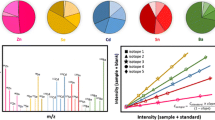Abstract
The quality of the determination of compound-specific isotopic content at natural abundance by gas chromatography–isotope ratio measurement–mass spectrometry (GC-irm-MS) relies on the stability of the voltage generated by the ion detector Faraday cages. The application of GC-irm-MS to the determination of δ13C (‰) and δ15N (‰) is now routine. However, for numerous applications, it is necessary to determine both the isotope content (δ15N) and the quantity (in micromoles) of analyte present. We now show that it is possible for nitrogen-containing compounds to measure how much analyte is present with an irm mass spectrometer linked to a GC by exploiting the integrated N2 total ion current intensity (Vs) generated by measuring the 15N/14N isotope ratio. The method is validated over a range of concentration (2–70 mmol/L) and δ15N (−70 to +50‰) values for six molecules of diverse chemical nature and functionality (nortropine, norpseudotropine, nortropinone, cysteine, taurine, glutathione). It is shown that once the ion current is calibrated, the quantitative values are of a comparable quality to those obtained from GC with flame ionization detection (GC-FID). In addition, it is demonstrated that over a definable range, the δ15N (‰) value is independent of the quantity of analyte introduced, confirming the validity of this method.



Similar content being viewed by others
References
Kangani CO, Kelley DE, Delany JP (2008) New method for GC/FID and GC-C-IRMS analysis of plasma free fatty acid concentration and isotopic enrichment. J Chromatogr B 873:95–101
Lafaye A, Labarre J, Tabet JC, Ezan E, Juniot C (2005) Liquid Chromatography−Mass Spectrometry and 15N metabolic labeling for quantitative metabolic profiling. Anal Chem 77:2026–2033
Marks L, Iglicki F, Rakotoambinina B, Thuillier F, Messing B (1995) A gas chromatographic/electron impact mass spectrometric method for the isolation and derivatization of plasma taurine for use in stable isotope tracer kinetic studies. J Mass Spectrom 30:1687–1693
Valerio A, Baldo G, Tessari P (2005) A rapid method to determine plasma homocysteine concentration and enrichment by gas chromatography/mass spectrometry. Rapid Commun Mass Spectrom 19:561–567
Hobbie E, Werner R (2004) Intramolecular, compound-specific, and bulk carbon isotope patterns in C3 and C4 plants: a review and synthesis. New Phytol 161:371–385
Tea I, Ferchaud-Roucher V, Küster A, Darmaun D, Robins RJ (2007) Determination of 13C isotopic enrichment of glutathione and glycine by gas chromatography/combustion/isotope ratio mass spectrometry after formation of the N- or N,S-ethoxycarbonyl methyl ester derivatives. Rapid Commun Mass Spectrom 21:3245–3252
Menand C, Pouteau E, Marchini S, Maugere P, Krempf M, Darmaun D (1997) Determination of low 13C-glutamine enrichments using gas chromatography-combustion-isotope ratio mass spectrometry. J Mass Spectrom 32:1094–1099
Fuller BT, Fuller JL, Harris DA, Hedges RE (2006) Detection of breastfeeding and weaning in modern human infants with carbon and nitrogen stable isotope ratios. Am J Physic Anthropol 129:279–293
Küster A, Tea I, Sweeten S, Rozé JC, Robins RJ, Darmaun D (2007) Simultaneous determination of glutathione and cysteine concentrations and 2H enrichments in microvolumes of neonatal blood using gas chromatography-mass spectrometry. Anal Bioanal Chem 390:1403–1412
Houben E, Hamer MH, Luypaerts A, De Preter V, Evenepoel P, Rutgeerts P, Verbeke K (2010) Quantification of 15N-nitrate in urine with gas chromatography combustion isotope ratio mass spectrometry to estimate endogenous NO production. Anal Chem 82:601–607
Kosieradzka K, Tea I, Gentil E, Robins RJ (2010) Determination of the natural abundance 15N of nortropane alkaloids by gas chromatography-isotope ratio mass spectrometry of their ethylcarbamate esters. Anal Bioanal Chem 396:1405–1414
Filer CN (1999) Isotopic fractionation of organic compounds in chromatography. J Labelled Cpd Radiopharm 42:169–197
Botosoa EP, Silvestre V, Robins RJ, Rojas JMM, Guillou C, Remaud GS (2009) Evidence of 13C non-covalent isotope effects obtained by quantitative 13C nuclear magnetic resonance spectroscopy at natural abundance during normal phase liquid chromatography. J Chromatogr A 1216:7043–7048
Kosieradzka K (2010) Mesure des effets isotopiques cinétiques lors de la dégradation d’alcaloïdes tropaniques par les souches de bactéries Pseudomonas AT3 et MS2. PhD thesis, University of Nantes, France
Tea I, Antheaume I, Besnard J, Robins RJ (2010) Determination of the natural abundance δ15N of taurine by gas chromatography-isotope ratio measurement mass spectrometry. Rapid Commun Mass Spectrom 24:3380–3386
Molinié R, Kwiecień RA, Silvestre V, Robins RJ (2009) Determination of nitrogen-15 isotope fractionation in tropine: evaluation of extraction protocols for isotope ratio measurement by isotope ratio mass spectrometry. Rapid Commun Mass Spectrom 24:4031–4037
Shinebarger SR, Haisch M, Matthews DE (2002) Retention of carbon and alteration of expected 13C-tracer enrichments by silylated derivatives using continuous-flow combustion-isotope ratio mass spectrometry. Anal Chem 74:6244–6251
Prevost S, Nicol T, Monteau F, André F, Le Bizec B (2001) Gas chromatography—combustion—isotope ratio mass spectrometry to control the misuse of androgens in breeding animals: new derivatisation applied to testosterone metabolites and precursors in urine samples. Rapid Commun Mass Spectrom 15:2509–2514
Fay LB, Métairon S, Montigon F, Ballèvre O (1998) Evaluation of taurine metabolism in cats by dual stable isotope analysis. Anal Biochem 260:85–91
Meier-Augenstein WJ (1999) Use of gas chromatography-combustion-isotope ratio mass spectrometry in nutrition and metabolic research. Curr Opin Clin Nutr Metab Care 2:465–470
Meier-Augenstein WJ (1999) Applied gas chromatography coupled to isotope ratio mass spectrometry. J Chromatogr 842:351–371
Acknowledgments
We are most grateful to our colleague, Gerald Remaud, for critical comments on this manuscript and to Carol Wrigglesworth (Scientific English, Nantes) for linguistic corrections.
Author information
Authors and Affiliations
Corresponding author
Rights and permissions
About this article
Cite this article
Tea, I., Kosieradzka, K., Antheaume, I. et al. Determination of the concentration of nitrogenous bio-organic compounds using an isotope ratio mass spectrometer operating in continuous flow mode. Anal Bioanal Chem 401, 1263–1271 (2011). https://doi.org/10.1007/s00216-011-5182-1
Received:
Revised:
Accepted:
Published:
Issue Date:
DOI: https://doi.org/10.1007/s00216-011-5182-1




